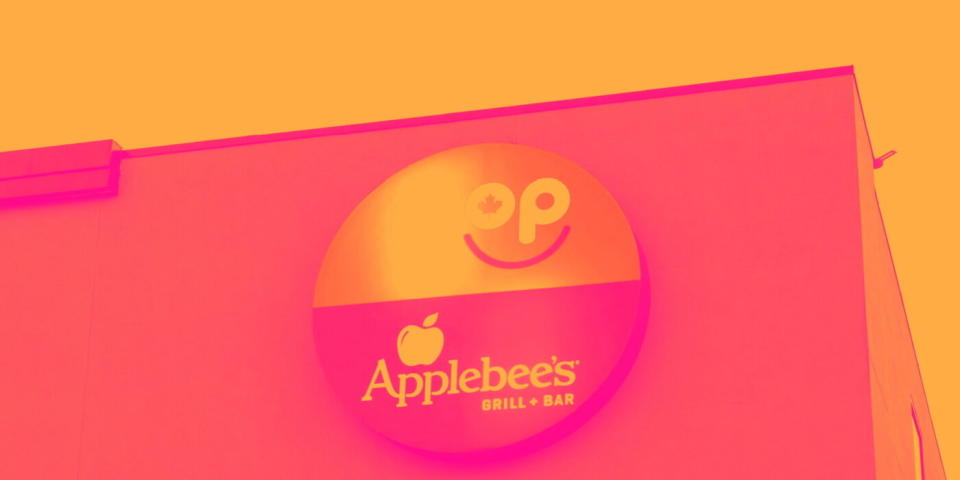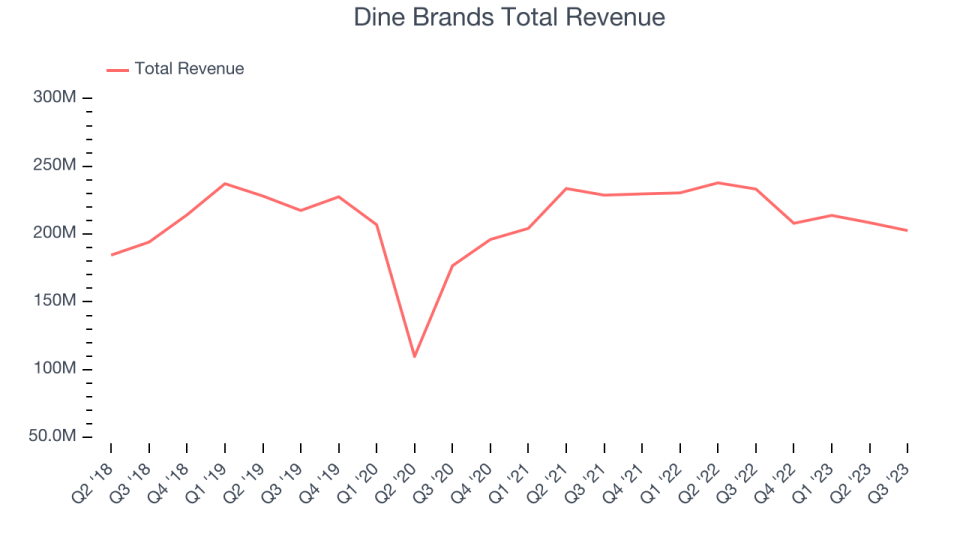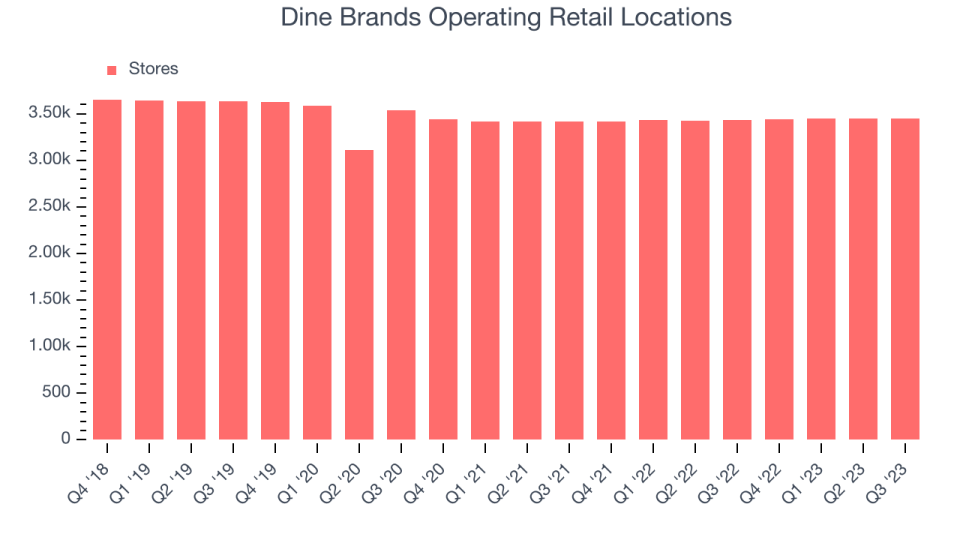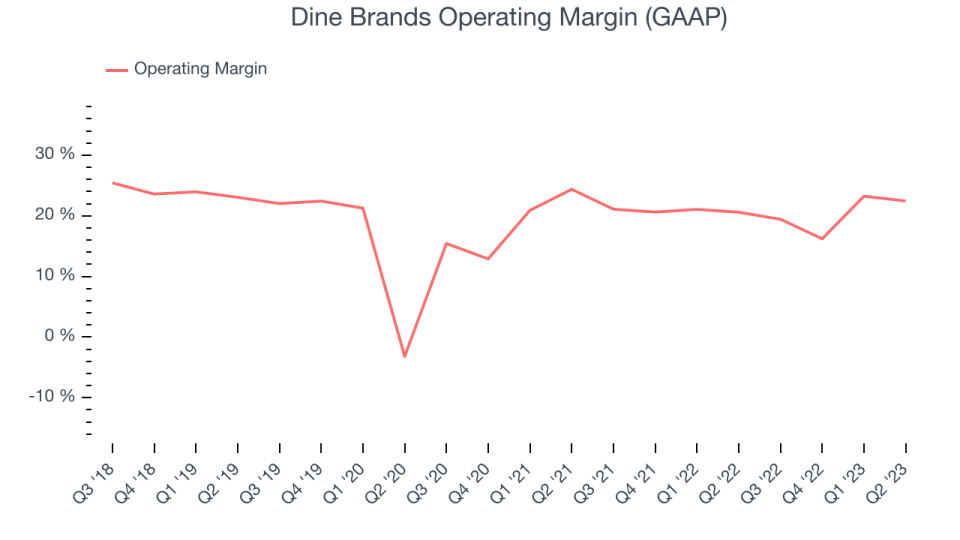Dine Brands (NYSE:DIN) Reports Sales Below Analyst Estimates In Q3 Earnings

Casual restaurant chain Dine Brands (NYSE:DIN) missed analysts' expectations in Q3 FY2023, with revenue down 13.1% year on year to $202.6 million. Turning to EPS, Dine Brands made a non-GAAP profit of $1.46 per share, down from its profit of $1.66 per share in the same quarter last year.
Is now the time to buy Dine Brands? Find out by accessing our full research report, it's free.
Dine Brands (DIN) Q3 FY2023 Highlights:
Revenue: $202.6 million vs analyst estimates of $203.5 million (small miss)
EPS (non-GAAP): $1.46 vs analyst estimates of $1.29 (12.9% beat)
Free Cash Flow of $27.4 million, up 38.2% from the previous quarter
Gross Margin (GAAP): 48%, up from 40.4% in the same quarter last year
Same-Store Sales were up 200% year on year
Store Locations: 3,446 at quarter end, increasing by 10 over the last 12 months
“Dine Brands maintained its course in the third quarter, leaning into our brands’ abundant value proposition and demonstrating solid performance as we continued to advance our strategic growth agenda,” said John Peyton, chief executive officer, Dine Brands Global.
Operating a franchising model where the company doesn’t own and operate all of its restaurants, Dine Brands (NYSE:DIN) is a casual restaurant chain that owns the Applebee’s and IHOP banners.
Sit-Down Dining
Sit-down restaurants offer a complete dining experience with table service. These establishments span various cuisines and are renowned for their warm hospitality and welcoming ambiance, making them perfect for family gatherings, special occasions, or simply unwinding. Their extensive menus range from appetizers to indulgent desserts and wines and cocktails. This space is extremely fragmented and competition includes everything from publicly-traded companies owning multiple chains to single-location mom-and-pop restaurants.
Sales Growth
Dine Brands is a mid-sized restaurant chain, which sometimes brings disadvantages compared to larger competitors benefiting from better brand awareness and economies of scale. On the other hand, Dine Brands can still achieve high growth rates because its revenue base is not yet monstrous.
As you can see below, the company's revenue has declined over the last four years, dropping 1.84% annually as it didn't open many new restaurants.

This quarter, Dine Brands reported a rather uninspiring 13.1% year-on-year revenue decline, missing analysts' expectations. Looking ahead, the analysts covering the company expect sales to grow 1.75% over the next 12 months.
While most things went back to how they were before the pandemic, a few consumer habits fundamentally changed. One founder-led company is benefiting massively from this shift and is set to beat the market for years to come. The business has grown astonishingly fast, with 40%+ free cash flow margins, and its fundamentals are undoubtedly best-in-class. Still, its total addressable market is so big that the company has room to grow many times in size. You can find it on our platform for free.
Number of Stores
A restaurant chain's total number of dining locations often determines how much revenue it can generate.
When a chain like Dine Brands doesn't open many new restaurants, it usually means there's stable demand for its meals and it's focused on improving operational efficiency to increase profitability. As of the most recently reported quarter, Dine Brands operated 3,446 total locations, in line with its restaurant count a year ago.

Taking a step back, Dine Brands has kept its locations more or less flat over the last two years compared to other restaurant businesses. A flat restaurant base means Dine Brands needs to boost foot traffic and turn tables faster at existing restaurants or raise prices to generate revenue growth.
Operating Margin
Operating margin is an important measure of profitability for restaurants as it accounts for all expenses keeping the lights on, including wages, rent, advertising, and other administrative costs.
in line with the same quarter last year. This indicates the company's costs have been relatively stable.

Zooming out, Dine Brands has exercised operational efficiency over the last eight quarters. The company has demonstrated it can be one of the more profitable businesses in the restaurant sector, boasting an average operating margin of 20.5%. On top of that, its margin has remained more or less the same, highlighting the consistency of its business.
Key Takeaways from Dine Brands's Q3 Results
With a market capitalization of $766.5 million, Dine Brands is among smaller companies, but its $140.1 million cash balance and positive free cash flow over the last 12 months give us confidence that it has the resources needed to pursue a high-growth business strategy.
While revenue missed by a bit, same store sales growth was better. Also it was good to see Dine Brands beat analysts' EPS expectations this quarter. That really stood out as a positive in these results. On the other hand, its gross margin sadly missed analysts' expectations and its revenue missed Wall Street's estimates. Overall, this was a mixed quarter for Dine Brands. The stock is flat after reporting and currently trades at $49.29 per share.
Dine Brands may have had a tough quarter, but does that actually create an opportunity to invest right now? When making that decision, it's important to consider its valuation, business qualities, as well as what has happened in the latest quarter. We cover that in our actionable full research report which you can read here, it's free.
One way to find opportunities in the market is to watch for generational shifts in the economy. Almost every company is slowly finding itself becoming a technology company and facing cybersecurity risks and as a result, the demand for cloud-native cybersecurity is skyrocketing. This company is leading a massive technological shift in the industry and with revenue growth of 50% year on year and best-in-class SaaS metrics it should definitely be on your radar.
Join Paid Stock Investor Research
Help us make StockStory more helpful to investors like yourself. Join our paid user research session and receive a $50 Amazon gift card for your opinions. Sign up here.
The author has no position in any of the stocks mentioned in this report.
